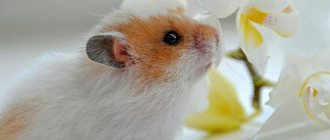- home
- Housing
11.04.2018
With the appearance of a hamster in the house, the owners have a question: where to place the pet. Which is better: a terrarium and aquarium for a hamster or a cage? And can their pet live in an ordinary jar? You will find answers to these questions below in the article.
A jar instead of a cage
Usually, loving owners buy a beautiful and spacious cage for a furry pet. But there are also individuals who put a tiny creature in a jar and think that the hamster is comfortable there. But under no circumstances should you keep your hamster in a jar for the rest of its life! In such conditions, the pet will not last long; you can be sure that he will get sick and die.
Article on the topic: Cage for the Djungarian hamster, housing for the Djungarian hamster (photo)
Compared to a cage, a jar does not have a single advantage, but there are more than enough disadvantages:
- very little space. Home will be cramped even in a three-liter jar, the animal will have nowhere to run.
- The hamster furniture will not fit into the jar. The only thing you can fit into it is a house or a feeder with food;
- There is nowhere to attach a hanging drinker. Firstly, there is no grate from which it is convenient to hang the sippy cup, and secondly, all the free space has already been occupied by the feeder;
- there will be nothing to breathe in the jar, because air will only enter through the neck;
- fumes from feces and urine, primarily poisonous ammonia, will remain inside the glass prison, because the air in such a structure does not circulate at all. You will have to change the bedding and wash the jar well 2-3 times a day, otherwise the fluffy will simply die from suffocation;
- lack of air circulation will provoke increased proliferation of pathogenic microorganisms, and your pet will be susceptible to infectious diseases;
- bank - the house is very unstable. It is easy to accidentally knock it over or sweep it off the table. By the way, a Syrian hamster is quite strong enough to knock over a jar on its own;
- if there is also a cat living in the apartment, then she will quickly get the fluffy one in this precarious apartment.
Lack of space for movement and lack of air can quickly kill a small animal. Therefore, it is allowed to keep a hamster in a jar for no more than half an hour, that is, while cleaning its cage.
An alternative to a jar during sanitary work can be a cardboard box or a plastic 5-liter bottle with slots.
Nutrition
The key to your pet's health is proper nutrition. Try to feed the dwarf at the same time. 7-8 am and 8 pm are ideal when the hamster starts to wake up.
Morning feeding should include succulent food, protein and boiled vegetables. In the evening, you should give the dzhungarik dry food, cereal and some kind of treat.
If you are caring for a pregnant female, feed her 4 times a day at regular intervals.
Main menu
The basis of the Djungarian diet should be:
- dry food designed specifically for Djungarian hamsters;
- nuts (except almonds) and seeds;
- dried fruits;
- grain sprouts;
- cereals;
- seedless berries (grapes are allowed in small quantities);
- fresh fruits and vegetables;
- non-starchy vegetables, cooked without salt;
- fresh herbs, lettuce leaves;
- leaves and dried twigs of deciduous and fruit trees;
- rose petals (those purchased at a flower shop are not suitable, as they have been treated with pesticides);
- carob and homemade crackers as a treat.
Keeping rodents in aquariums
Aquariums and terrariums are much better for hamsters than a small glass jar. Firstly, they are stable, and secondly, they have much more space. But is it possible to keep a hamster in an aquarium permanently?
Article on the topic: Is it worth getting a turtle, the pros and cons of keeping land turtles and red-eared turtles at home
In principle, this is not prohibited. But a hamster terrarium must meet the following requirements:
- Big square. For representatives of the Syrian breed, the optimal dimensions are 50 x 100 cm, but for the Djungarian breed this is just a palace!
- Low height. The optimal height of the walls is 30 cm. This way, air exchange will occur freely, and the second tier can be installed. The maximum height is 40 cm. If you make the roof higher, then fresh air will not reach the fluffy in sufficient quantities.
- Additional ventilation slots. In order for air to circulate better in the hamster’s apartment, additional slits will have to be cut in the walls. This is quite difficult to do. In addition, the homa should not reach them. If you do not know how to cut glass, then a terrarium for a hamster should be a temporary option, but not a permanent home.
- Lattice ceiling.
It is also worth noting that each homa should have its own separate aquarium.
Detailed consideration
Let's start with the disadvantages of this house option:
- Air circulation in glass containers is poorer.
- The animal will constantly be surrounded by the smell of its feces.
- If there is insufficient air circulation, bacteria multiply quickly.
- To prevent your pet from getting sick, its house will need to be cleaned twice as often as its cage.
- It may be difficult to install the drinking bowl, which is usually suspended. You shouldn’t use an ordinary bowl, because the baby can get wet all the time.
- Glass is a cold material. To keep your baby's paws from freezing, you need to use a good layer of filler.
Now it’s worth considering the main advantages of this choice:
- The pet will not be able to chew the walls of its house.
- The baby is not afraid of drafts.
- The unpleasant odor spreads less throughout the room.
- When kept, there will be much less noise from the active pastime of pets.
- The filler will not spill outside the animal's house.
The transparent walls make it easy to observe your pet and you can take photos.
Advantages and disadvantages of aquariums
Compared to a cramped jar, an aquarium for a hamster is a winning option. But if you compare it with a cage, you can identify a number of pros and cons. Let's look at them in more detail.
Let's start with the disadvantages:
- air circulation in glass terrariums is poorer;
- the hamster is constantly surrounded by the smell of its own feces;
- in conditions of reduced air circulation, bacteria multiply faster;
- the terrarium will have to be cleaned 2 times more often than the cage so that the animal does not get sick;
- It will be more difficult to install a hanging drinking bowl for an animal in an aquarium;
- glass and fiberglass are quite cold materials: a very thick layer of filler is required so that the animal’s paws and tummy do not freeze.
Of course, these disadvantages are quite serious, but glass houses also have their advantages.
- Khoma will not be able to chew through the glass and escape;
- Fluffy will not be affected by drafts, even if the window is open in the room with the terrarium;
- the unpleasant smell will not spread throughout the room;
- there will be much less noise, which will give you the opportunity to sleep peacefully at night without taking the hamster palace out of the room;
- the filler will not spill out, and the fluffy himself will not be able to throw pieces of food and poop through the walls, as a result - cleanliness and order around the cage;
- Through the transparent glass it is very convenient to observe the animal and arrange photo sessions (of course, without flash), the rods will not fit into the frame.
Article on the topic: Cage for a Syrian hamster: sizes, types, photos
That is, the aquarium also has many advantages. But what will tip the scales? Think about it: all the shortcomings only harm the hamster; they do not affect the owners in any way. Now analyze the advantages. A person benefits a lot from them, but what about a hamster?
In fact, it doesn’t matter to a home whether the room smells delicious or whether there is bedding lying around his cage. Only the owners worry about this. That is, those who choose a glass terrarium as a place to live for a hamster think first of all about themselves, and not about the comfort of the pet. Remember: it is much better to keep your furry friend in a wire cage or mesh cage!
Features of caring for pet hamsters
Like most other animals, pet hamsters can be stressed. As a rule, their causes may be the following circumstances:
- changes in the animal's daily routine;
- lack of water;
- external control over his offspring;
- the presence of lighting in the cage where he sleeps;
- introducing another animal, even a hamster.
Also, in order to prevent stressful situations for your hamster, do not talk loudly or scream when near his cage, do not make any sudden movements in this place so that the animal does not feel danger. If you speak to your hamster quietly and calmly, he will behave accordingly.
Also consider the following tips for caring for pet hamsters:
- The hamster must be moved to another cage using a special tube. First he is nudged by hand so that he can explore a new place;
- You need to care for your hamster's teeth carefully and on an ongoing basis. If he eats food that is not too solid, then his teeth grow very quickly , and this interferes with normal food intake;
- The cage should be cleaned several times during the week. During cleaning, the hamster is pulled out of the house and transferred to another place, for example, into a prepared jar. The bedding is changed and the cage is washed with detergent. The toilet area should be cleaned regularly as it gets dirty;
- The hamster needs to be walked regularly. For this purpose, a special playing place will be equipped. You can make obstacle courses, mazes and something similar. At the same time, all sharp objects must be removed from the resting place, and nearby pieces of furniture and decor must be as durable as possible in terms of stability;
- You need to regularly monitor the animal’s claws, especially if it has reached a certain age. Nails are trimmed using special manicure scissors. Do not use a nail file; your hamster may get scared and hurt himself. If the pigmentation of the hamster's claws is weak, they are trimmed only in daylight or table light. If injured, during this procedure, the paw is wrapped with a bandage, and the cage itself is washed so that the wound does not become infected;
- Hamsters do not like water very much, so bathing unless necessary is not recommended. But if you still need to bathe the hamster, be careful not to let water get into its ears, eyes or nose. Don't let the hamster out of your hands so that he doesn't bite you. You need to bathe the animal only if it is very dirty, using rabbit shampoo for this purpose. After bathing, hold your hamster in your hands for a while to warm it up, and then wrap it in a soft towel.
Cleaning the cage
The unpleasant smell of the cage will not bother you if you regularly clean it once every 1-1.5 weeks. Place the hamster in the carrier. Remove the dirty litter, leaving a small amount (this will make the hamster feel more comfortable), and add fresh litter. Once a month, carry out wet cleaning, washing the bottom of the cage with water and laundry soap.
Bathing
Never wash your hamster in water! If you notice that your pet's coat is matted and not shiny, give him a sand bath. To do this, purchase a special bathing suit (a three-liter jar will do) and sand for chinchillas. Pour some sand into the bathing suit and throw in the dzhungarika. Soon you will be watching him wallow in the sand and clean his skin.
As you can see, caring for dzhungarikas is not very difficult. Clean the cage regularly, provide your hamster with access to water and fresh food and, of course, play with him regularly. These simple measures will ensure your pet has a happy and healthy life!
Source
Alternative solution
We have already found out that a cage is much better suited for keeping a hamster at home. But if you have a spare aquarium at home, it can also be adapted to suit a hamster’s needs. For example, in a terrarium you can arrange a relaxation and entertainment room for your beloved pet.
Here are the items you can place in the aquarium:
- Running wheel on a stand.
- Various pipes and labyrinths.
- Spacious shelter.
- Toilet (if the animal is accustomed to it).
- Bath with sand for bathing.
- Various stairs and bridges.
The hamster can be moved into the terrarium to play, especially if all the attractions do not fit into the cage. You can also place the animal in the rest room while you tidy up its permanent home.
Don't forget that in addition to toys there should also be essential items. Be sure to leave a bowl of food, saucer or bottle of water for your furry friend.
What to build from?
The material is very important. If the furniture is made of toxic substances, the hamster will have choking attacks or allergies.
Therefore, try to use sharp-smelling adhesives like Moment to a minimum.
So, here's what's suitable for construction:
- wood and plywood;
- non-toxic plastic (water bottles, food containers);
- glass and ceramic objects.
- household waste: Popsicle sticks, 5-liter bottle caps, packaging boxes, cardboard tubes, old toys and other rubbish.
Tools are selected individually depending on the complexity of the work. It is better to fasten parts with nails, a stapler, PVA glue, tape or electrical tape. As a last resort, you can use superglue, but in those places that the homa cannot chew.
When children take part in the process, they want to color everything. Explain to the child that it is better not to use gouache for this purpose, because it will stain the animal’s bedding and fur. Water-based paint, wax crayons, or alcohol-based markers are good alternatives.
Sanitary difficulties
We especially highlighted one of the disadvantages of the aquarium. The fact is that a large glass house is extremely difficult to clean. After all, usually the terrarium consists entirely of glass, and is not installed on a glass tray. When washing, it is easy to cut yourself or break the hamster's house.
Article on the topic: A toilet for a hamster: how to equip and train your pet, how to make it yourself
And you will have to wash it more often than a regular cage with a wire frame. In addition, the lack of free air circulation allows not only dangerous bacteria, but also mold to actively multiply. It is very difficult to remove it from joints, and sealants cannot provide a 100 percent guarantee that it will not appear. To disinfect the aquarium as much as possible, you will have to use aggressive agents, and many of them are toxic to hamsters.
A hamster can be kept in wide aquariums, but the animal will be much more comfortable in a cage. A house made of twigs is more consistent with hygienic standards for small rodents. But if you have an empty terrarium, you can easily adapt it into a room with attractions for temporarily keeping a hamster.
Situation
For a hamster to live comfortably, one cage is not enough. First of all, you need to take care of the feeder and drinking bowl. Any cup is suitable as a feeder, but you need to take the choice of a drinking bowl seriously. To prevent the hamster from turning over the water, you need to select a heavy vessel with a wide base.
To give the animal some privacy, place a small house in the aquarium or terrarium. You can purchase it at a pet store or make it yourself. For your pet's outdoor games, a wheel is best suited. This is an objective necessity. In nature, a hamster is not a fat hulk, as is usually depicted in cartoons, but a fairly active animal that runs through the fields in search of food. The wheel is a kind of sublimation of natural activity. As a rule, the animal enjoys doing “fitness”. They spin “like squirrels in a wheel.” It is advisable to purchase a metal wheel. The wooden structure looks good, but the rodent will deal with it faster than we would like. Place branches and small driftwood in the animal’s home. The hamster, like all rodents, is not averse to sharpening its teeth on wood.
If you do everything carefully, correctly and beautifully, then a cheerful, healthy and playful pet will delight you for a long time. As far as a hamster's life will allow.
Did you like the article? Share with friends: [supsystic-social-sharing >
- Related Posts
- How much does a hamster cost?
- Hamster or rat, which one should you prefer?
- Does the hamster smell or how to get rid of the unpleasant rodent smell in the apartment
Is it possible to keep a hamster in an aquarium and terrarium?
When buying an animal such as a hamster for home, you should first acquire a cage to keep it. Modern pet stores offer several types of designs for dwarf animals. Most often, livestock breeders prefer a cage design. But there are two more options - a terrarium and an aquarium. Could such houses for dwarf rodents become an alternative to a cage house? To what extent does an aquarium and terrarium for a hamster meet the requirements for keeping such a pet? In this article we will tell you about this.
Hamster in an aquarium and terrarium
Delicious "walnut" staircase
From the empty shells of several walnuts you can make an excellent toy for your pet. In addition to the empty shell halves, you need to prepare in advance:
- a thin nail with a sharp end;
- hammer;
- a strong thread as long as the height of the cell;
- medium size washer.
In all prepared half-shells, you need to carefully make a hole in the center. This is done by driving a nail (there is no need to leave it in the resulting hole). You need to thread a thread through the holes to make the shells into a kind of beads. An important nuance - all halves must be turned in one direction, with the exception of the last one. In a vertical position, the beads look like a stack of bowls standing on a tubercle.
A washer is tied to the end of the thread coming out of the last (lower) shell so that the thread is securely fastened and the structure does not fall apart. The upper end of the thread is tied to the “ceiling” of the cage so that the lower shell lies on the bottom, but the “beads” do not sag. You need to put treats for the hamster in all the resulting bowls. Climbing the structure, the pet will take away a tasty prize at each stage of “conquering the peak”.
Terrarium
Despite the fact that the cage design with metal rods for hamsters is very popular and in demand, it also has some disadvantages:
- there is a high risk of the hamster getting outside the home;
- a hamster living in such a cage will constantly scatter bedding outside the cage, etc.
In this case, pet store sellers offer livestock breeders terrariums, the choice of which is very large.
When buying such housing for your hamster, choose a model made of inorganic glass. Plexiglas wears out and fades very quickly. Also, if you plan to keep multiple pets in it, you will need a larger model. This must be taken into account, since rodents staying in close quarters will lead to disastrous consequences.
Article on the topic: How to make toys for a hamster with your own hands at home
Advantages and disadvantages
The advantage of such designs is as follows:
- Accurate calculation of dimensions. When purchasing such a structure, you will not need to take measurements, since in structures of this type all the proportions of the bottom and walls are maintained.
- Almost all models have a ventilation system installed.
- As a rule, all terrariums consist of two parts - a transparent base and a plastic tray.
- In such housing, your hamster will always be visible, and it is very convenient to watch him from all sides.
- The terrarium is very easy to clean.
- This design is ideal for those owners who do not like noise.
This design also has disadvantages, although they are not significant. When installing such a home, the owner needs to think about how to attach the drinking bowl. Although many people use suction cups or place heavy containers on the floor. Then the hamster simply will not be able to turn it over.
Another negative point is that in a terrarium that is made of glass, you will not have the opportunity to pet your furry. But you can easily get it out by opening the lid of the structure.
Where to look?
You can look for an escaped hamster in an apartment anywhere. Tiny animals can hide in the most inaccessible places. If he escaped before your eyes, you should immediately examine the place where he disappeared. If you don’t find the fluffy one, close the entrance door to the room.
But if there are many rooms in the house, the search task becomes much more complicated. After all, each room will now have to be monitored separately. Most often, fugitives do not leave the room where their cage is located, but there are exceptions. So what to do if the hamster runs away, where to look for your pet?
First of all, inspect the following places:
- Cabinets and other furniture. The hamster may hide behind or under the backs of dressers and cabinets. If he escaped in the bedroom, first look under the bed.
- Carpets, rugs. A frightened animal may well crawl under the rug, especially if it does not fit well to the floor. To avoid crushing the crumbs, it is better to remove the rugs.
- Heat and water supply system. Rodents love warm places, so they are able to hide under the sink or near the radiator.
- Pantry. If you have a pantry at home, then this is a paradise for a rodent. It's always quiet there and there's something to eat. If the furry friend settled down there, the search will last for weeks.
Basically, if a hamster runs away, it could be anywhere. But one thing is certain: small rodents do not jump very high, so you should look for the animal in the lower part of the premises.
Aquarium
Hamsters do well in aquariums
Many breeders have doubts about whether it is possible to keep a hamster in an aquarium. All this is due to ignorance. Worried if this will harm your hamster? Believe me, there is no reason to worry!
If you use a structure made by specialists, then rest assured that it contains everything a pet rodent needs for a full life and development. This design is made of glass (organic or regular). The top of the aquarium is covered with a metal or plastic mesh, which prevents the rodent from getting out of the home.
To ensure ventilation, the bottom of the aquarium is drilled in several places at a distance of 10 cm from the floor.
Article on the topic: Hamster wheel: types and how to choose (photo)
The glass bottom is covered with felt, sawdust, hay or other material that is sold in pet stores.
The dimensions of the housing should be selected based on the size of the pet. For example, aquariums measuring 100x40 cm are suitable for dwarfs. Syrian rodents will need a larger aquarium. If desired, such a design can be made with your own hands. To do this you will need glass, glass glue and a tool for cutting the material - a jigsaw.
A product made with your own hands will be no worse than a store-bought one. Plus, you will save money.
Advantages and disadvantages
The most important advantage is that in the aquarium you can provide the hamster with everything necessary for full-fledged living, development and reproduction. And it doesn’t matter what breed the pet will be.
In addition, aquariums for hamsters have other qualities:
- living in such a house, your hamster will not be able to scatter food and sawdust, which often have to be cleaned up after rodents in a cage;
- Through the glass walls it is convenient to observe the rodent’s antics from any side;
- a hamster living in such a house feels protected and completely safe;
- Through the aquariums you can pet your animal without having to remove it.
Aquariums have only one drawback - they need to be washed every time they are cleaned. There is no other way to restore order in such a house.
Treatment
You can relax here. You won't have to vaccinate your hamster; you'll save your hard-earned money on vaccinations and veterinarian fees. Firstly, these rodents rarely get rabies. Secondly, vaccinating an animal that lives only two or three years is simply not profitable and pointless. Virus-resistant antibodies simply do not have time to be developed in the hamster’s body during its short life.
But you cannot do without treatment completely. The rodent may develop parasites - worms and fleas. To make your animal feel comfortable, you will have to buy a special powder and treat it. This powder costs about 100 rubles, and it won’t last a hamster’s entire life.
Of course, rodents sometimes get more seriously ill. But in each specific case, you need to consult a veterinarian, who will prescribe the appropriate treatment, the cost of which can be found out directly at the veterinary clinic.
Recommendations
If you decide to purchase a terrarium or aquarium for your pet, you should definitely take into account some nuances:
- Choose a design according to the size of your pet.
- It is better if it is a large-sized housing in which you can install additional attributes - a wheel, a nesting house, a ladder, a drinking bowl and feeders.
- Choose a model made of ordinary glass. It is durable and highly decorative for several years.
Total
As Vladimir Mashkov’s hero said, “let’s be like a grandma”: on the day you buy a hamster, you will have to spend at least 2,750 rubles. Its annual maintenance will cost you 17,140 rubles with corn as a filler, or 9,940 with hay. And that's the minimum. Now let's remember how much the hamster itself costs. Well, doesn’t he deserve to be called a “budget eater”? Another thing is that the costs, in our opinion, are worth it. The Djungarian hamster Pesha, who posed for this article, belongs to one of our editorial staff. And this employee assures that he does not regret a single penny spent, because in return the gray pet gives his family a sea of positive emotions.
Is it possible to keep hamsters in them?
Like any other housing for pets, terrariums and aquariums have both positive and negative sides.
pros
Glass houses have the following advantages compared to other places where hamsters are kept:
- food and bedding particles will not be scattered outside the house;
- the noise from its activity causes less inconvenience to the owners;
- You can see the animal better through the glass;
- in such a house the hamster feels much better, he is less timid;
- you can pet your pet without removing it from its home;
- Cleaning such a room is much more convenient.
Minuses
In addition to the advantages, such housing has its disadvantages:
- it must be thoroughly washed periodically;
- fresh air comes only from above;
- difficulties with securing the drinking bowl;
- to pet the animal, you need to move the lid;
- small field of activity.
Operating rules
Now you know how to make a hammock for a nimble animal, but you need to know how to use it correctly. Failure to follow safety precautions may result in injury to your hamster.
So, here are the recommendations for using a hanging bed:
- It is better to place the hamster hammock on the second tier of the cage.
- It should not be hung too high above the surface of the second floor, so that the animal does not suddenly hurt itself.
- At first, watch the animal to see if it is gnawing on a new piece of furniture. If the home does not try to test the furniture, then you can leave the hammock overnight.
- Fluffy can bring food into the bed and litter. He is also capable of “playing whale” right in the hammock. Therefore, you will have to wash it periodically with soap.
Our tips will help ensure your hamster's safety and comfort.
Thus, making a comfortable hanging bed for your pet is not difficult at all. The main thing is to have the desire and a little free time. You can also get creative and attach ladders to the hammock or decorate it in some way.
How to make an aquarium for a hamster with your own hands
Despite the fact that today there are a large number of different houses for hamsters on sale, anyone can make an aquarium or terrarium with their own hands. To do this, we offer you step-by-step instructions with precise instructions.
Tools and materials
To assemble an aquarium yourself, you will need the following tools:
- sealant;
- paper tape;
- plastic spacers 2 mm thick;
- glue gun;
- clamps;
- furniture corners;
- glass cleaner;
- acetone or alcohol;
- dry wipes;
- stationery knife;
- putty knife.
Step-by-step instruction
To create an aquarium you must complete the following steps:
- Degrease all glass surfaces.
- We take the part that will be the bottom, glue tape to all edges on one side, which will be inside.
- The glass is placed on a previously cleaned surface, on which identical blocks are laid so that the glass is on a hill.
- Then we take small sides, which are also covered with tape. The edge that will be in contact with the bottom is not glued end-to-end; there is left a gap from the edge, which is equal to the thickness of the glass + 2 mm.
- The same manipulations are done with large glasses. Gaps from the edge are left at the point of contact with the bottom and small sides.
- All parts are connected so that the gaps are equal, spacers are placed. In order for the walls to hold, they are clamped on top with furniture corners. Small bars are placed on top of the side bars close to the glass to make them more stable.
- When everything is assembled and immobilized, the spacers are removed and the seams begin to be filled with sealant. You need to do this very slowly so as not to miss anything, and do this until the sealant appears on the outside.
- After all the seams are filled, take a spatula and level the sealant, getting rid of excess.
- Finally, remove all the tape and leave the aquarium to dry for the required amount of time.
Article on the topic: Drinking bowl for a hamster: how much does it cost, types, methods of attachment
Organization of a sand bath
Bath container
You can purchase a bathing suit at a pet store (the smallest one intended for birds), or use improvised means. The container should be deep so that the homa does not scatter sand around and fall out, rolling from side to side.
It’s good if the container is transparent - watching rodents wash themselves is incredibly funny. The Syrian hamster usually rubs its sides, “rides” around the sandbox, dwarf hamsters roll over on their backs and tumble.
The container must be stable so as not to tip over. Use:
- carrying container for rodents;
- a plastic container for wet wipes with the lid removed;
- glass round terrarium, aquarium;
- food container, deep bowl.
Sand
The sand for bathing hamsters should not be too coarse so that the particles do not injure the skin, but not too fine so that the dust does not irritate the eyes and respiratory tract.
Can not use:
Normal from sandbox
Natural sand is a source of parasites and infections and contains impurities and debris. Even if it is calcined and sifted, the construction sand is too coarse and scratches the skin of the animal.
For parrots
Cleaning feathers is different from cleaning the fine hairs of thick fur. Sand for parrots is not only hygiene, but also mineral nutrition. Crushed shells, activated carbon and other impurities are added to it. It is not suitable for rodents.
Volcanic
Volcanic sand is sand only in name and has nothing in common with the usual quartz. This is a clay mineral powder (aluminosilicates, zeolite), light and fine. It is harmful to hamsters - they start sneezing.
Sand for chinchillas
To buy a bath filler at a pet store, you need to know what kind of sand is needed for hamsters. It is not produced specifically for these rodents. It makes no sense to ask the consultant whether chinchilla sand can be used for hamsters. Experience of hamster breeders: possible, but not everyone.
A good sand for a hamster is one that does not contain talc. Before purchasing, study the composition. Trusted companies use the mineral sepiolite and quartz, and the small grains of sand have a round shape.
Suitable options indicating the country of origin and approximate price:
- JRFarm “ChinchillaSand” (250-350 rubles per 1 kg, Germany);
- Vitakraft “Sandy” (420-440 rubles per 1 kg, Germany);
- Padovan “Bathing Sand” (560-600 rubles for 2 l., Italy);
- Beaphar “XtraVital” (500-600 rubles for 2 liters, the Netherlands);
- Versele-Laga “Chinchilla Bathing Sand” (600-650 rubles for 2 liters, i.e. 1.3 kg, Belgium).
When calculating how much sand for hamsters costs, you should remember that the packaging will last a long time for one animal: the sand can be used repeatedly. Sand is packaged for a chinchilla, which weighs 10 times more than a chinchilla.
A layer of at least 2-3 cm is poured into the bathing suit.
Bathing process
To prevent the bath from turning into a sleeping hut with supplies or a toilet, the container is not left in the cage on a permanent basis. Sand for hamsters - Djungarians and Syrians - is an irresistible temptation to relieve themselves. Therefore, after the bathing procedure, it is sifted, and especially responsible owners - calcined. Store the sand in a tightly closed container so that it does not accumulate moisture.
Bathing is carried out 1-2 times a week. The hamster should not be left alone; the bathtub should be removed as soon as the pet loses interest in it. The procedure should not last more than half an hour.
This bath is a good alternative to water procedures. The owner does not need to think about how to bathe a hamster in the sand so as not to harm the pet. The animal will do everything itself, guided by instinct.
Difficulties only happen the first time. The hamster may simply ignore the new object. Then the question arises - how to accustom a hamster to sand. It's enough to wait. The bathing suit is placed in the cage (or, conversely, the rodent is placed in it) only when the animal has woken up for night activity, is well-fed and alert. After a quarter of an hour, the curious pet will begin to rummage through the bathing suit, and soon begin to lie around.
How to set up an aquarium (terrarium) for a hamster
After purchasing or independently assembling an aquarium (terrarium), it is important to properly arrange the interior space.
Filler
The filler for the aquarium can be made of paper, it can be napkins or newspapers; harder paper is not suitable, as the animal may get hurt. Sawdust from pine or aspen is also suitable, as they are softer in structure. Despite the fact that sawdust absorbs odors better, such bedding needs to be changed less often, but some animals are allergic to it.
Sleeping house
All animals and even hamsters need a place to sleep, so as not to make the house dirty by using paper from which the rodent will make its own nest; you can buy a plastic one at a pet store. It is recommended to put hay in it, from which the animal will make its own burrow, taking an active part in the arrangement.
Feeder and drinker
The feeder should be placed at a height convenient for the animal; you can purchase it at any pet store or make it yourself by taking a capacious lid with sides 1.5 cm high.
A bowl is not suitable for drinking, as the hamster will turn it over, contaminating the bedding. An excellent option is a nipple drinker, which is placed on the wall using suction cups. The hamster drinks little, especially when the diet includes fruits and vegetables, but it still needs fresh water.
Nipple drinker for hamsters
Toilet
It is quite difficult to train this animal to use the toilet; it will simply need bedding that will absorb liquid and odors. His feces are very small, so they will not pollute the area of the house much.
running wheel
It can be purchased at a pet store. There are different types and designs of running wheels, it is important to choose the right one for your aquarium. This device will be a great entertainment and sports equipment to maintain the health of your pet. Since in the wild they run a lot, in captivity, if they are deprived of this, they can begin to gain weight with all the ensuing negative consequences.
Article on the topic: Hamster cage: how to make the right choice
Don’t be upset if you don’t notice the animal’s movements during the day, since most often activity occurs at night or early in the morning; at this time you are simply sleeping.
Mineral stone
To sharpen teeth, it is important to have a mineral stone in the house, which can be purchased at a pet store or simply put a piece of chalk or branches of fruit trees.
As you can see, a terrarium or aquarium has both its advantages and disadvantages in comparison with other rodent homes. Whether they are purchased or made by yourself depends on your desire and ability to handle glass. It is important that your pet likes the new house and creates ideal living conditions for it.
Sources:
https://ohomjakah.ru/soderzhanie/akvarium-terrarium-banka-dlya-homyaka-mozhno-li-v-nih-derzhat-gryzuna https://slonvkvartire.ru/homyaki/terrarium-i-akvarium.html https: //pets2.me/bok/1327-kak-sdelat-i-obustroit-akvarium-dlya-homyaka-svoimi-rukami.html
Choosing a hamster
If you want your pet to please you with good health and good mood for a long time, choose it responsibly. Determining whether an animal is healthy is not at all difficult. When purchasing, be sure to pay attention to the following points:
- The animal's fur should be shiny and free from bald spots.
- Clear eyes, absence of suppuration and spots are an important indicator of the animal’s condition.
- Be sure to inspect the animal's anus and the fur around it. They shouldn't be dirty. Diarrhea often indicates an infectious disease.
- The nose should be clean and pinkish in color.
- If the dwarf is sleeping, be sure to wake him up and observe his behavior. Hamsters are very active by nature. Lethargy can be caused by illness or severe stress, which often happens in crowded and stuffy cages of a pet store. Animals are known to be more susceptible to illness during times of stress, so avoid purchasing.
Many people cannot decide which gender to choose. If you do not plan to engage in breeding, then the issue of gender is not important for you. It is known that the character, habits and behavior of Djungarians do not depend on this factor.
Don't forget to consider transporting your pet home. To transport a hamster, veterinarians recommend purchasing a special carrier. At the bottom you should put a little sawdust, as well as a few pieces of carrots. If transportation will take more than 2 hours, be sure to provide the animal with access to water by hanging a drinking bowl.
You can carry a hamster in your arms only if it is not afraid of you and the journey will take no more than half an hour. This method is completely unsuitable for the first transportation of dzhungarika home.











